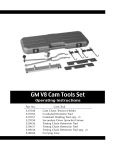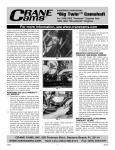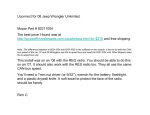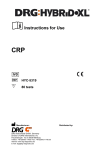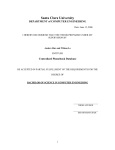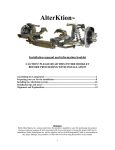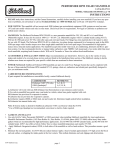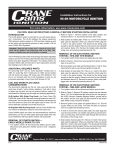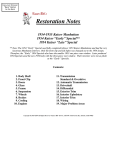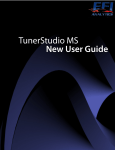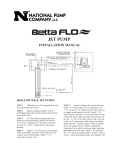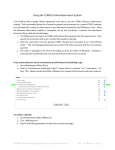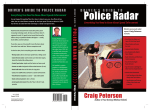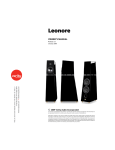Download Tips on Choosing the Right Cam
Transcript
Crane Cams & Valve Train Products Section Basic Tips on Choosing the Right Cam Cam selection accuracy begins with knowing how you intend to use the vehicle, engine and drivetrain modifications already made or planned, and the lifter type (Hydraulic, Hyd. Roller, Mechanical (“Solid” or “Flat Tappet”), or Mech. Roller you wish to use. You’ll find additional information to help you choose the correct cam on Pages 14 through 17. We urge you to take a little extra time now in making your selection. This will insure that you make the right choice, the first time! To choose the correct cam and valve train for your engine, vehicle and application follow the steps below: What To Look For First: First, find your engine make, number of cylinders, year, and original engine displacement as listed in cubic inches or metric reference. (Example: Chevrolet, 1986, 350 cu. in.) Decide Which Lifter Style: Decide on the lifter type you wish to use in your engine. For convenience and ease of maintenance we recommend a hydraulic cam and lifters, either “flat-face” or hydraulic roller for most street performance and daily-driving applications. NOTE: Passenger car engines up through 1987 model year generally used conventional hydraulic or mechanical (solid) lifters and cams. In the GM family 1988-up pass. car and 1996-up truck engines were factory equipped with hydraulic roller cams and lifters. (Light trucks (pick-up’s, etc.) generally used flat-face lifters and cams up through 1995 model year.) We offer many different hydraulic roller cams, our exclusive Crane Cams hydraulic roller lifters (drop-in installation), correctlength pushrods and other valve train components for converting a flat-face lifter engine to the tremendous power benefits found with a Crane hydraulic roller cam. Look under Hydraulic Roller Retrofit Cams for specific engine details. Determine Your Vehicle’s 60 MPH Cruise RPM: Determine your Cruising RPM At 60 MPH by reading Page 14 (Getting Information). Match your Cruise RPM At 60 MPH with the information found under Application) See the gear ratio/tire diameter chart on Page 15 to help you determine this RPM. Note: This is critical in making the right choice for a vehicle that is street driven. Be sure your information is accurate! Choose Your Cam: Use the Cruise RPM At 60 MPH numbers and match this RPM range with the RPM Power Range numbers shown on the left-hand page. Be sure to consult the Application info before you make your cam choice. Pay particular attention to the recommended engine compression ratio. Also, engines using aluminum cylinder heads dissipate heat more rapidly and can therefore use approximately +.75 ( three-quarters “point”) compression ratio. (Example: Iron heads, 9.0:1 c/r; Alum. heads, 9.75:1 c/r) Remember: If you are in doubt, always choose the next milder cam profile. Be sure to specify the Part Number when ordering! Choose Your Valve Train Components: The Valve Train Buyer’s Guide (Pages 284 through 385) contains additional product applications and additional information not found on the regular applications pages. Be sure to consult these pages for optional products that will add even more horsepower, torque, rpm, response and reliability to your cam selection. 866-388-5120 • 386-236-9983 FAX 13 Crane Cams & Valve Train Products Section Getting Information How to Determine Your Cruising RPM at 60 MPH 1.Hold a constant 60 MPH and check the tachometer, if so equipped. You can also hook up a test-type tachometer, providing it has a sufficient RPM range. 2.Using the reference chart below, locate your tire diameter (height) and rear end ratio, then read the RPM indicated. How to Determine Your True Rear Axle Ratio 1.The actual ratio, or a reference code, will normally be found on either a tag attached to a bolt, or will be actually stamped into the axle housing. Your car dealer can tell you how your vehicle is marked. 2.Raise both rear wheels of the vehicle, with the transmission in neutral. Make sure that you support the vehicle with safety stands and block the front tires. Make a reference mark on the driveshaft and on the housing. Next, without rotating them, make a mark on both of the tires and the fenderwells. With a friend watching the driveshaft carefully, rotate both tires at the same time exactly one revolution. The number of turns the driveshaft makes indicates the ratio, i.e.,: 3½ turns = 3.5 to 1; 2¾ turns = 2.75 to 1; etc. You an also use the above procedure the next time you have your vehicle lubed at the service station. 3.Many vehicles are equipped with overdrive-type transmissions. If this occurs, you must multiply your rear end ratio by the final transmission ratio. EXAMPLE: You have a 3.23 rear end ratio and a .85 high gear in the transmission: 3.23 x .85 = 2.75 final drive ratio. How to Determine Your Engine’s Compression Ratio 1.If your engine has stock-type pistons, and the original cylinder heads, you should be able to locate the compression ratio by: A. Checking your owner’s manual. B. Checking a repair or service manual such as “Chiltons” or “Motors”. C. Call your car dealer’s parts department with the engine description or serial number. 2.If your engine has non-stock pistons, refer to the piston manufacturer’s catalog. NOTE: If the cylinder heads are not stock, check to see if they have the same size combustion chambers. If not, refigure the compression ratio. Milling the block or heads also affects the compression ratio. Contact a Crane Performance Consultant for additional information. 14 CRANECAMS.COM Crane Cams & Valve Train Products Section Getting Information (continued) RPM Shown at 60 MPH (Cruise RPM) RPM FORMULA: Rear End Ratio 2.18 2.50 2.74 3.08 3.23 3.50 3.73 3.90 4.10 4.56 4.88 Tire Diameter 24” 26” 1831 1690 2100 1938 2301 2124 2587 2388 2713 2504 2940 2714 3133 2892 3276 3024 3444 3179 3830 3536 4099 3784 28” 1570 1800 1973 2218 2326 2520 2686 2808 2952 3283 3513 30” 1465 1680 1841 2070 2170 2352 2507 2621 2755 3064 3279 MPH x Axle Ratio x 336 Tire Diameter 32” 1373 1575 1726 1940 2035 2205 2349 2457 2583 2873 3074 34” 1293 1482 1625 1826 1915 2075 2212 2312 2431 2704 2894 36” 1221 1400 1534 1725 1809 1960 2089 2184 2296 2554 2733 38” 1157 1326 1454 1634 1714 1857 1979 2069 2175 2419 2589 40” 1099 1290 1381 1552 1628 1764 1880 1966 2066 2298 2460 42” 1046 1200 1315 1478 1550 1680 1790 1872 1968 2189 2342 44” 999 1145 1255 1411 1480 1604 1709 1787 1879 2089 2236 46” 955 1096 1201 1350 1416 1534 1635 1709 1797 1998 2139 Finding Overall Tire Diameter, RPM, MPH, or Rear Axle Ratio OVERALL TIRE DIAMETER: MPH x Axle Ratio x 336 RPM RPM: MPH x Axle Ratio x 336 Tire Diameter MPH: RPM x Overall Diameter Axle Ratio x 336 Axle Ratio: RPM x Tire Diameter MPH x 336 866-388-5120 • 386-236-9983 FAX 15 Crane Cams & Valve Train Products Section Advanced Tips to Choose the Proper Camshaft Although pages 14 and 15 in this catalog outline the very basic steps in selecting the best camshaft for a particular application, we can certainly add to the criteria needed for the best possible results. For general street (or marine) applications, the following will help provide an enhanced guideline. Exactly what engine is it? This sounds really obvious, but a lot of folks aren’t really knowledgeable on what they’re working with. For example, “I’ve got a smallblock Chevrolet.” It could be a 1957-87 powerplant that was originally equipped with a flat faced lifter camshaft, or it could be a 1987-96 style engine that came with a hydraulic roller camshaft. Each basic engine requires a different style camshaft. Similar choices can also occurs with the evolution of big block Chevrolets, small block Fords, small block Mopars, and many others. In the 1970’s General Motors exchanged the Buick, Oldsmobile, and Pontiac bodies and engines, with some folks not understanding that the Buick 455, Oldsmobile 455, and Pontiac 455 V-8s are all totally different engines. Any information that can be obtained to verify which engine that the customer has, will help make the correct choice the first time. What cubic inch displacement is the engine? A smaller engine will usually require a shorter duration camshaft than a larger engine, given all other factors being equal. What compression ratio is the the engine? An answer of “stock” is not really sufficient, as compression ratios of most engines changed during their production runs, due to differing horsepower ratings, emissions concerns, the vehicle that it was originally installed in, etc. A basic generalization that higher compression ratio engines can use camshafts with larger (more radical) duration figures will normally apply. What cylinder heads do you have? Iron or aluminum, stock or or ported, standard combustion chamber size or milled? These factors are also critical. Aluminum cylinder heads dissipate heat more readily, enabling them to use slightly milder camshafts for best torque characteristics. A good approximation is that going from iron heads to aluminum heads is like lowering the compression ratio 0.75 (i.e.: a 9.25:1 engine with iron heads will have similar characteristics to a 10.00:1 engine with aluminum heads). Installing heads with smaller combustion chamers will raise the compression ratio, so don’t forget to take that into account. High compression combined with too mild a camshaft will cause problems with detonation, and reducing the ignition timing to compensate for this will usually hurt the torque and horsepower everywhere throughout the power band. What intake manifold is on it? In carbureted applications, a dual plane manifold will favor low-end and mid-range power, with a single plane unit being good for upper RPM usage. If you’ve got a single plane manifold on a relatively mild street machine, you may want a milder cam to pick up the bottomend torque. Do you have a supercharger/turbocharger/ nitrous oxide? All of these enhancements will greatly influence the camshaft recommendation. Supercharged combinations tend to have slightly lower compression ratios, with slightly milder camshafts on wide lobe separation. Turborcharged engines might have slightly lower compression ratios (or not, if an intercooler is used), with a mild cam used to minimize overlap area. Heavy NOX applications might need a longer exhaust duration with a wide lobe separation in order to relieve the greater exhaust heat that’s generated. Section Continued 16 CRANECAMS.COM Crane Cams & Valve Train Products Section Advanced Tips to Choose the Proper Camshaft (continued) What carburetor/throttle body are you using? The larger units favor upper-end performance, so a proper match here is essential to put the power into your intended RPM operating range. What altitude will this engine normally be used at? An engine at sea level will normally use a more radical camshaft than one at 5,000 feet (we’re back to the compression gauge/cylinder pressure factor again). What’s your cranking compression? With the advent and widespread usage of the cylinder leakdown checkers, most folks have forgotten about the compression gauge. This is still a very valuable tool to verify your cylinder pressure, as it will illustrate the effects of a camshaft (or compression ratio) change, which a leakdown tester won’t. Higher pressures will give an indication of how much ignition timing that you can run, what octane gasoline that’s required to prevent detonation, and help to provide a tuning baseline for varying atmospheric conditions. What idle quality and drivability factor are you looking for? This is the one area where the customer’s individual desires can influence overall choices. If a radical idle is wanted with no concern for vacuum readings, go with the higher duration/narrower lobe separation options. If a smooth idle with lots of low-end torque is the choice, use the shorter duration/wider lobe separation cam. Headers or stock exhaust manifolds? A good exhaust system can be really beneficial in most any application. Going to really large diameter systems in a mild application can hurt the torque curve, so don’t get carried away there. In V-8 situations, a crossover pipe is advised for dual exhaust systems. What transmission do you have? Manual vs. automatic, how many gears, additional stall speed in the converter? This will help determine how broad the power curve needs to be, with milder cams traditionally having better torque and drivability over a wider RPM range. All of this adds up to formulating a workable combination to produce the best overall performance that’s needed to get the job done. We see combinations every day that are put together with little thought to the overall picture. Too much compression ratio, in too heavy a car, and a single plane intake manifold, with low numerical rear end ratios: no camshaft will be able to make up for a drastic mismatch of components. If possible, try to help the customer obtain the correct components from the beginning of his project. This will produce the best results, with time and money being saved by not having to repurchase items that were poorly chosen the first time. What’s the rear end ratio and rear tire diameter? This will provide the basic operating and cruising RPM of the vehicle, one of the most critical portions of the camshaft selection process. Each of our grinds lists a basic operating band to help in the selection. How much does the vehicle weigh? Heavier cars may need milder camshafts with wider torque bands for best results. 866-388-5120 • 386-236-9983 FAX 17







